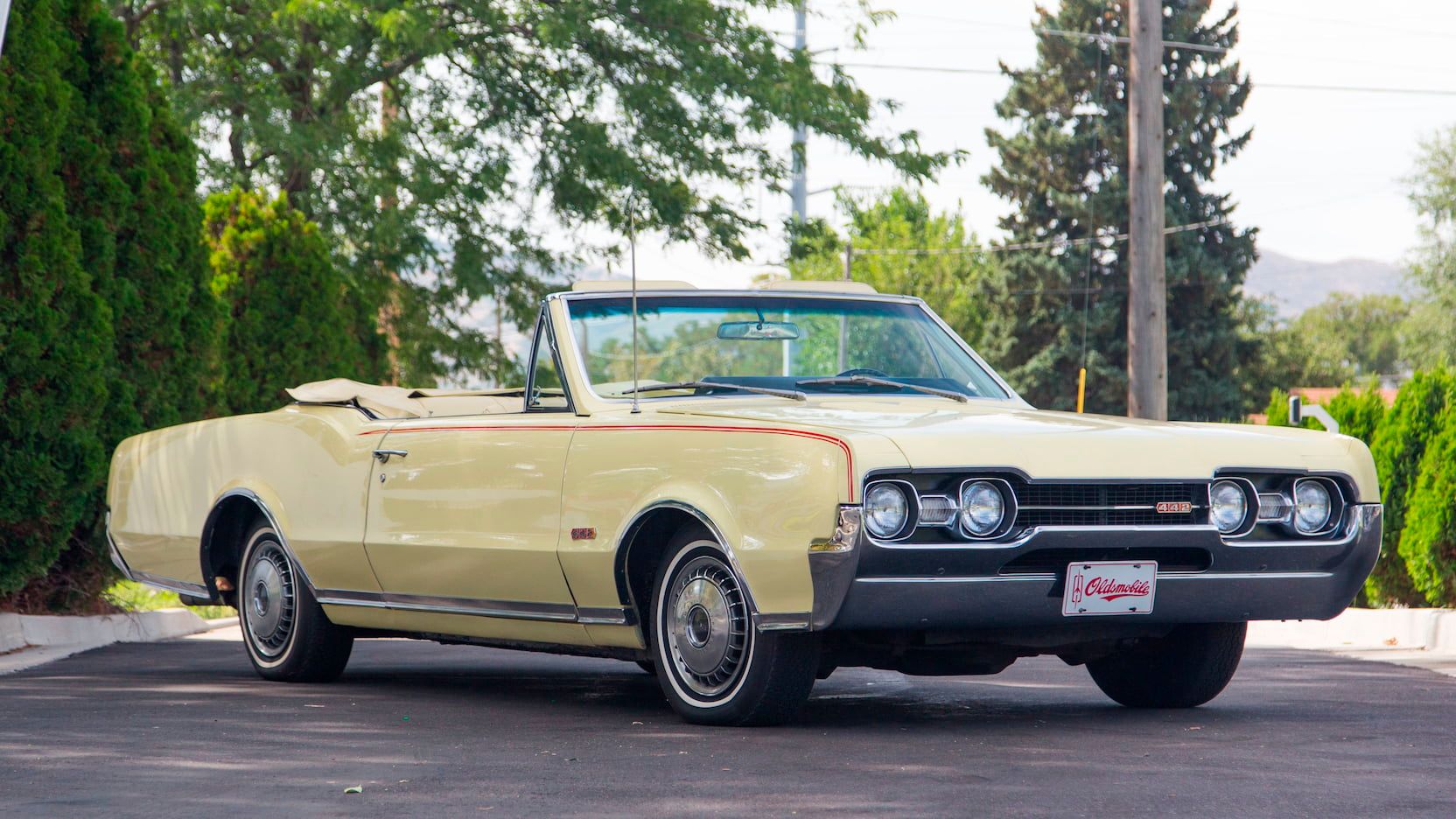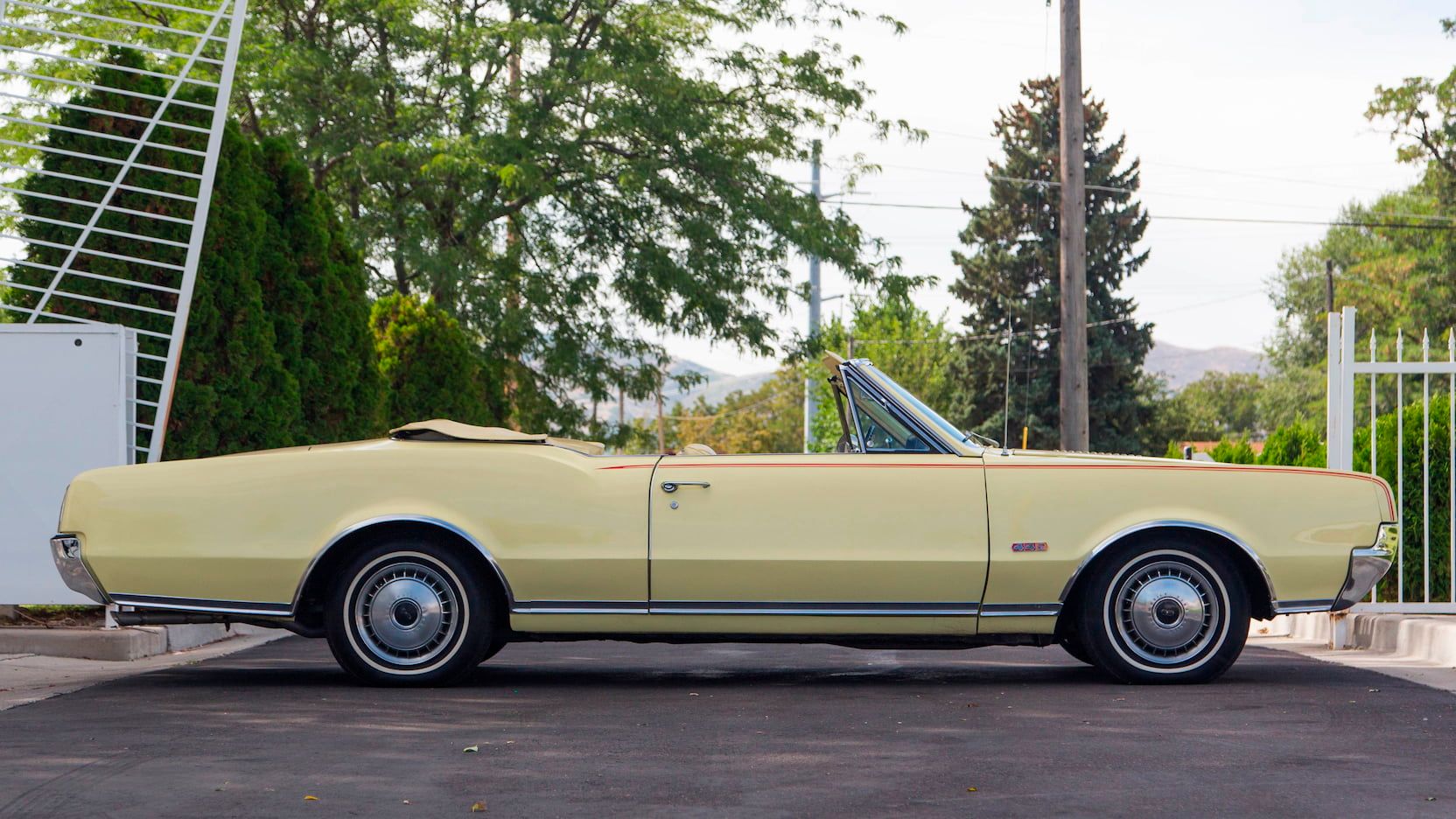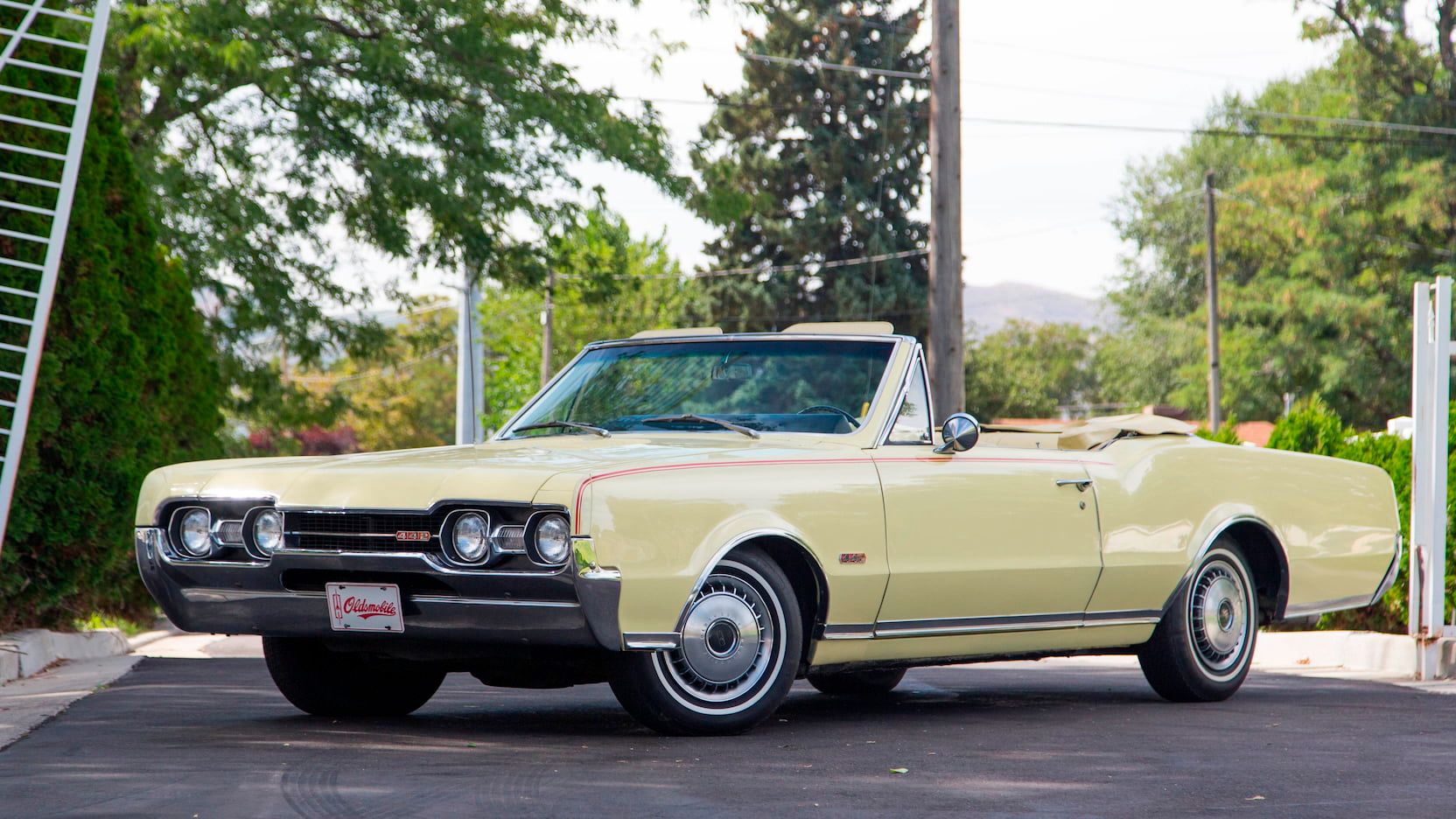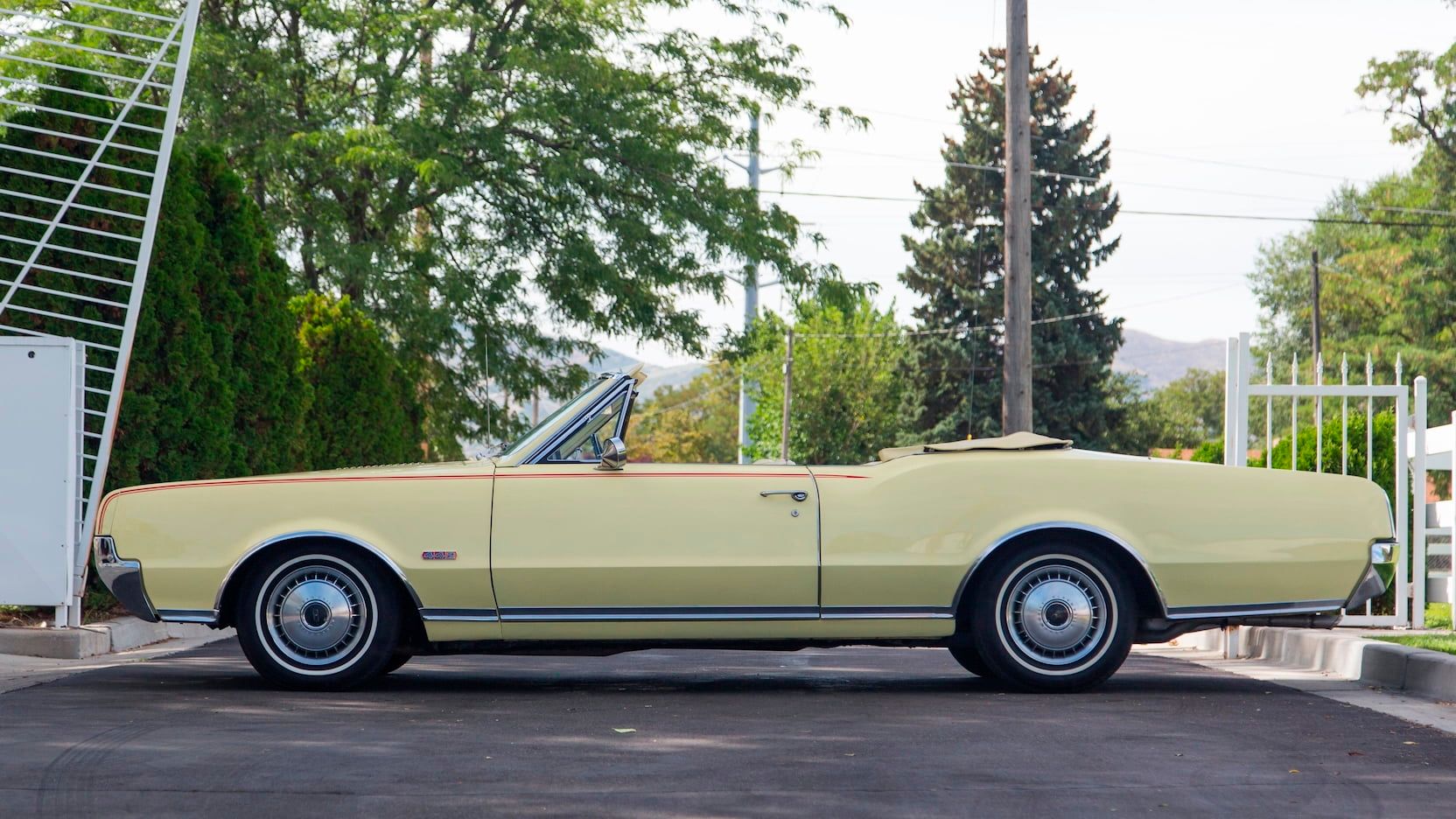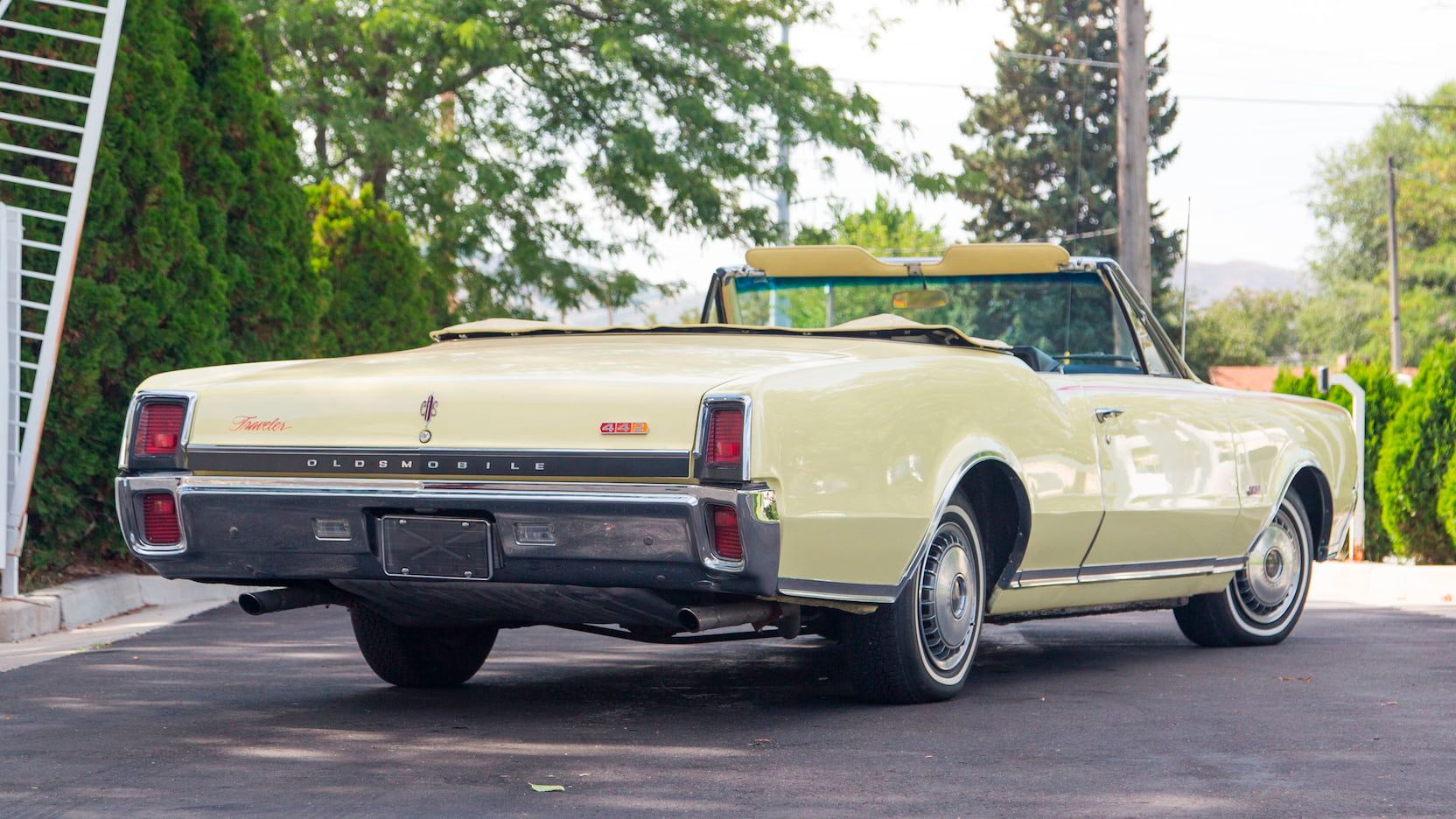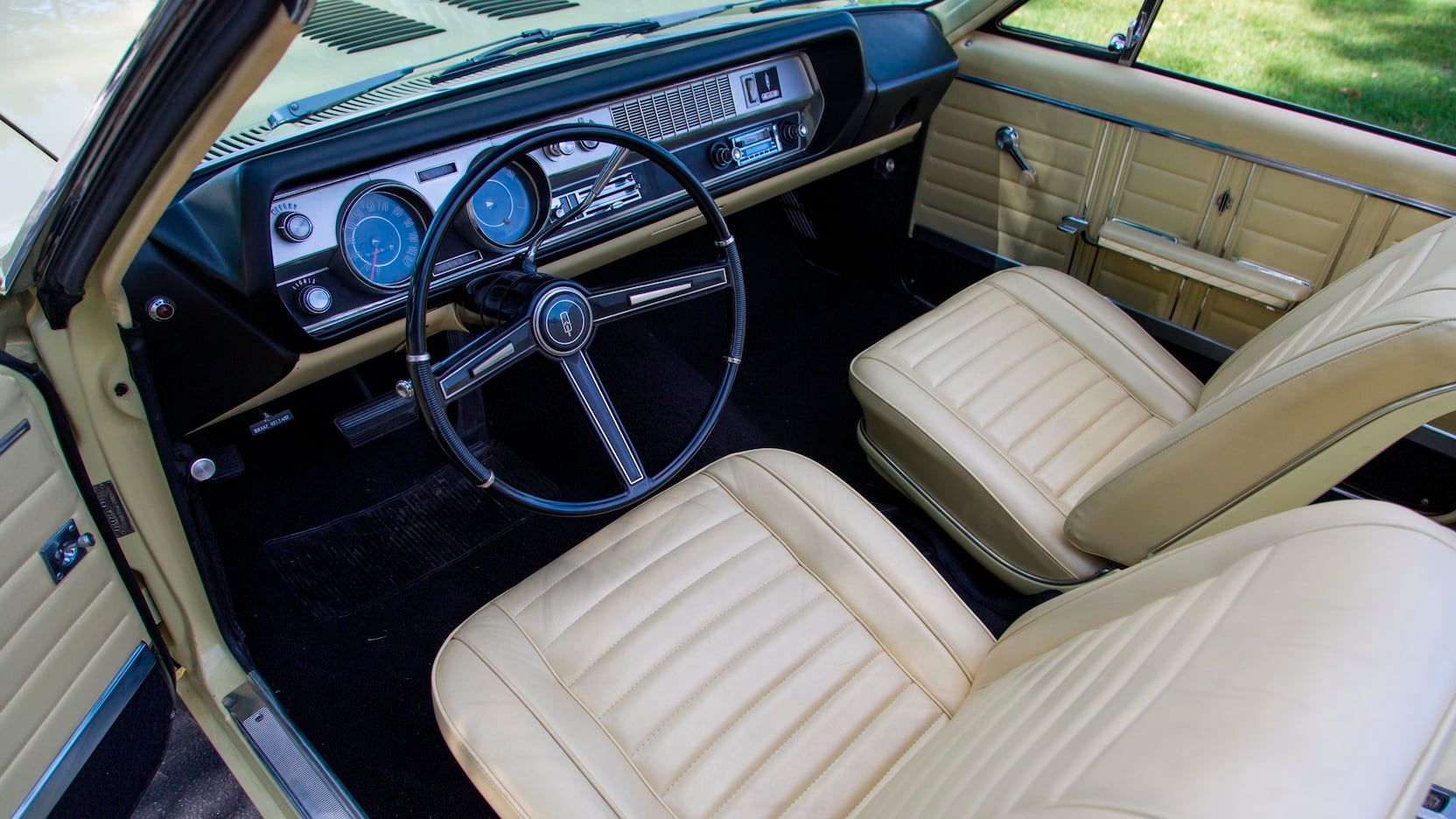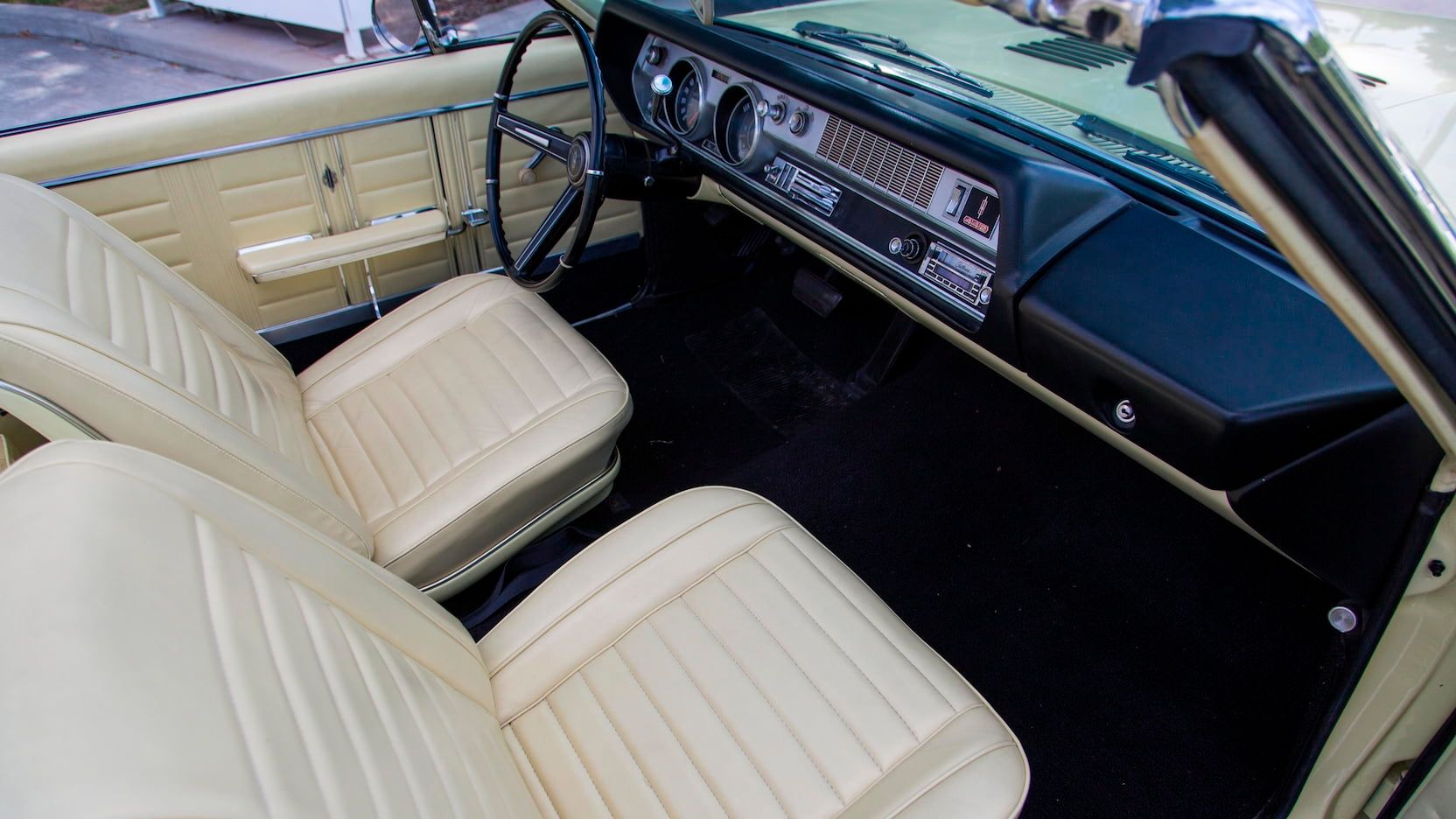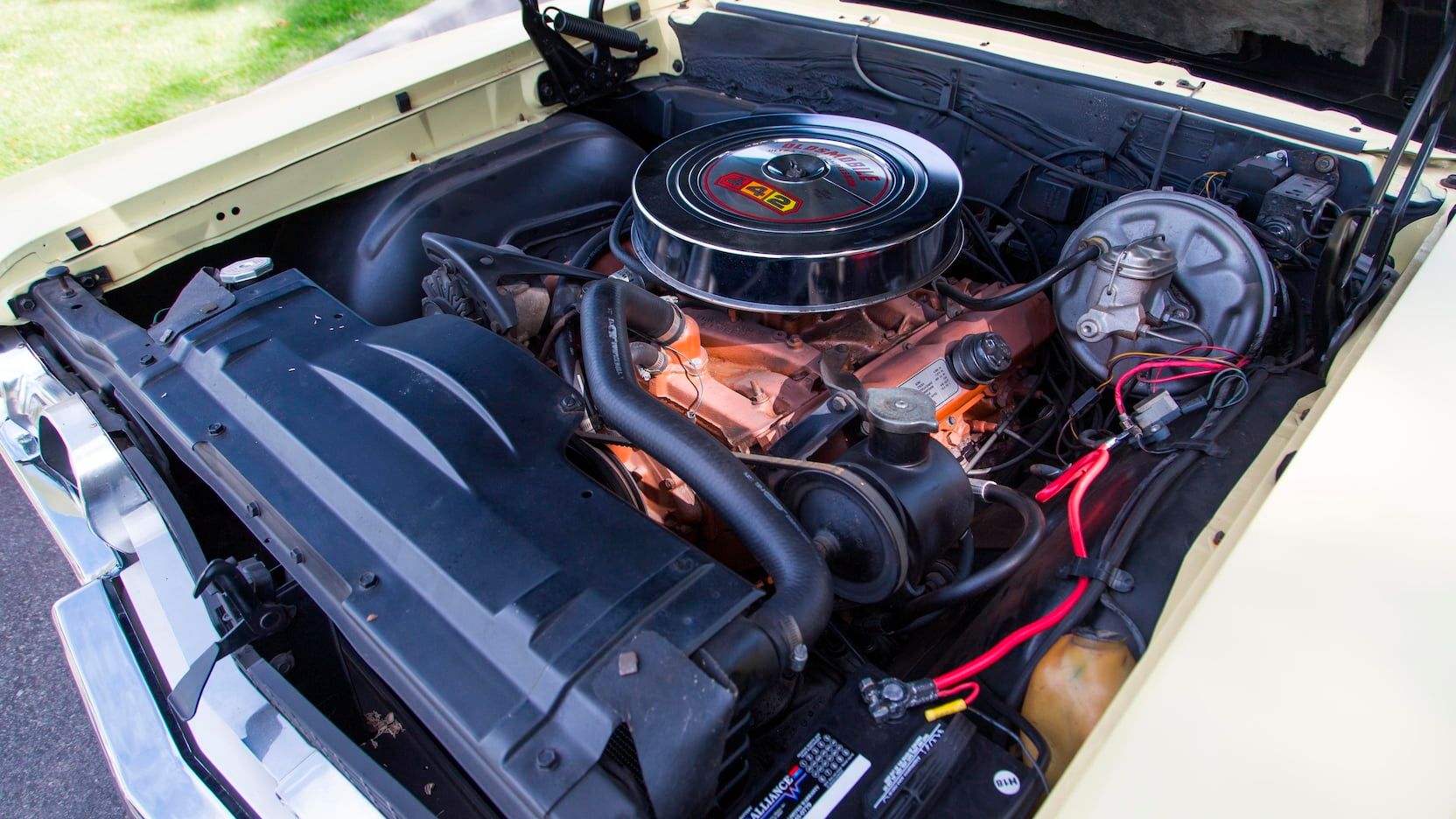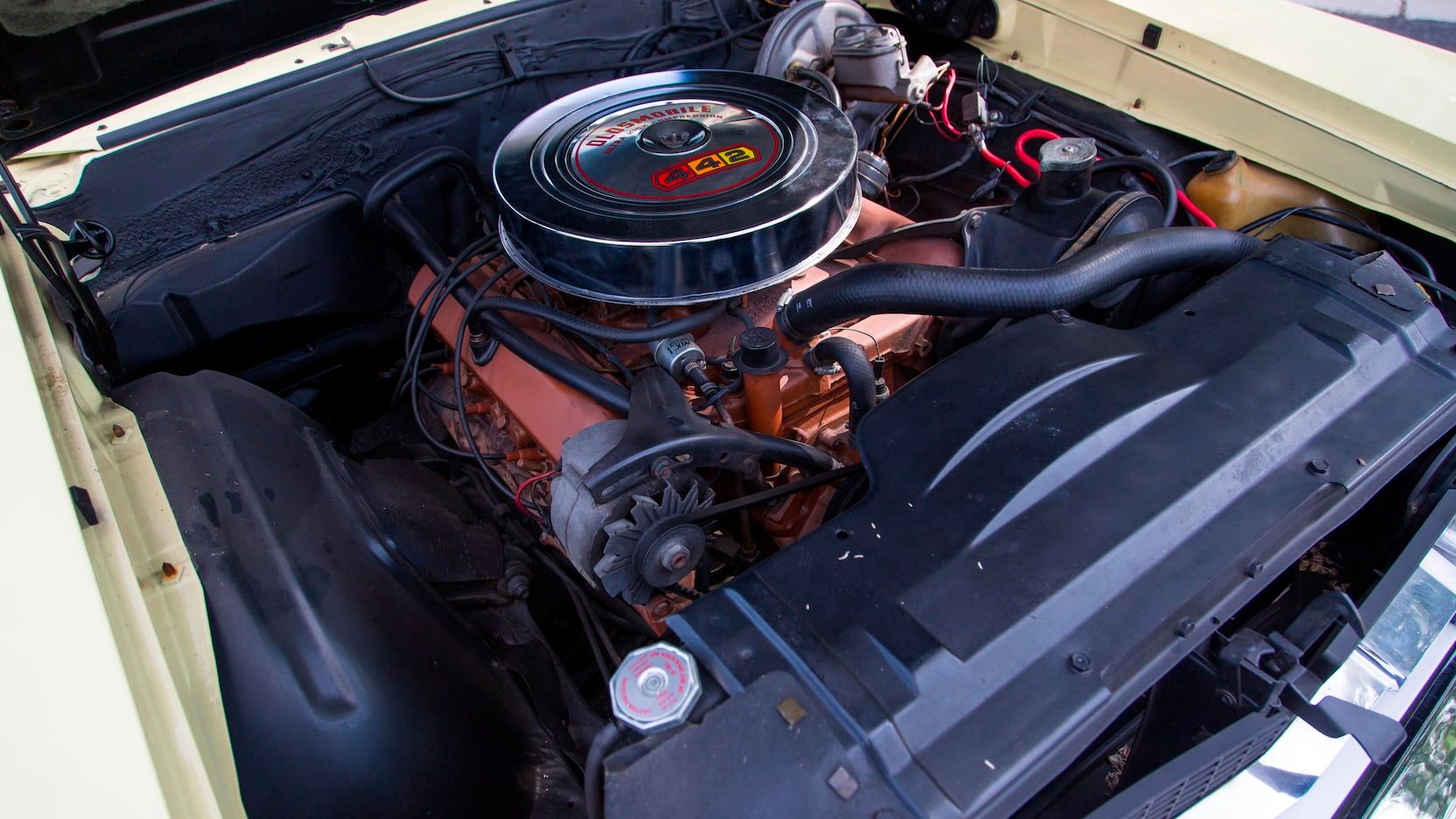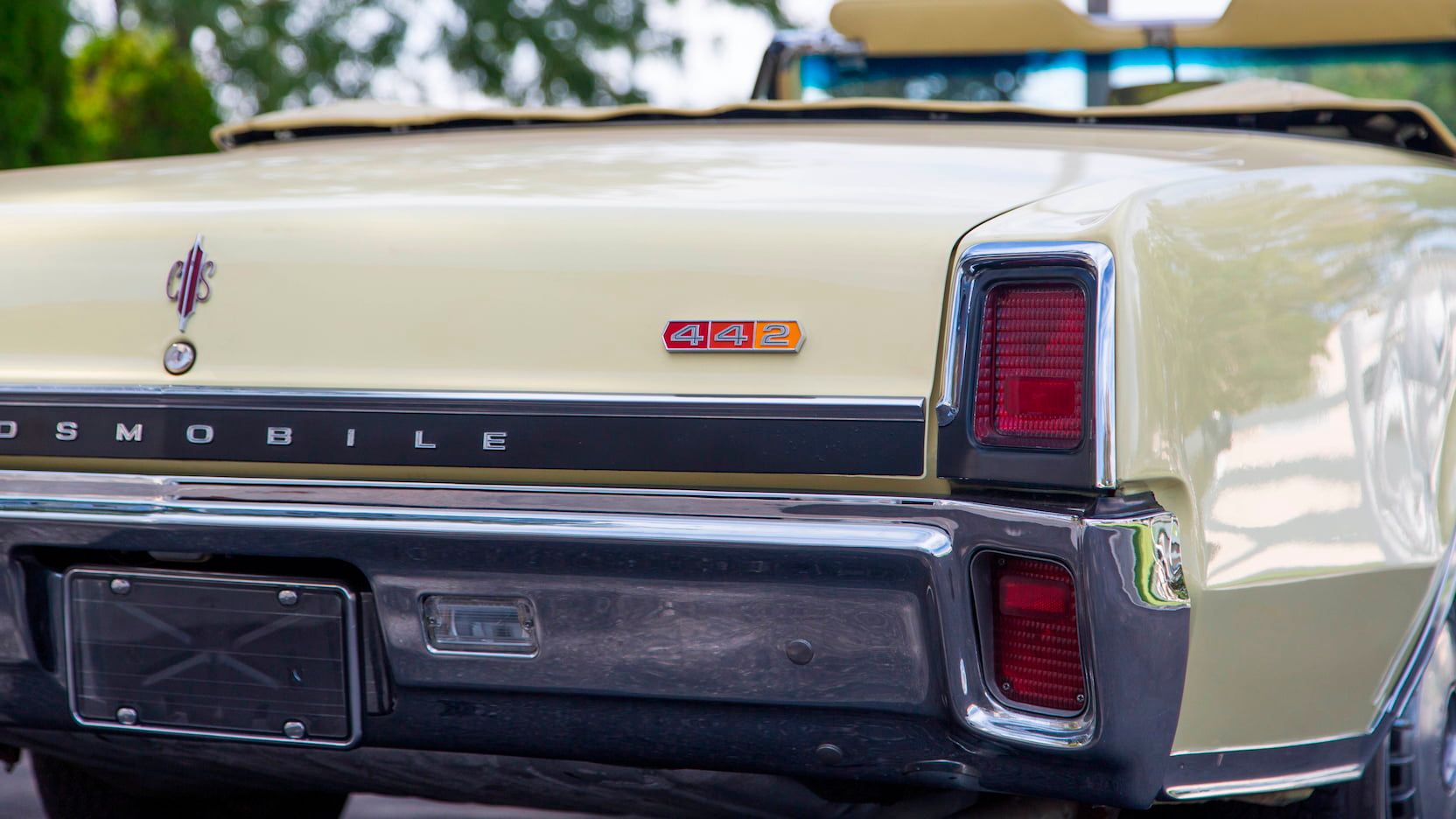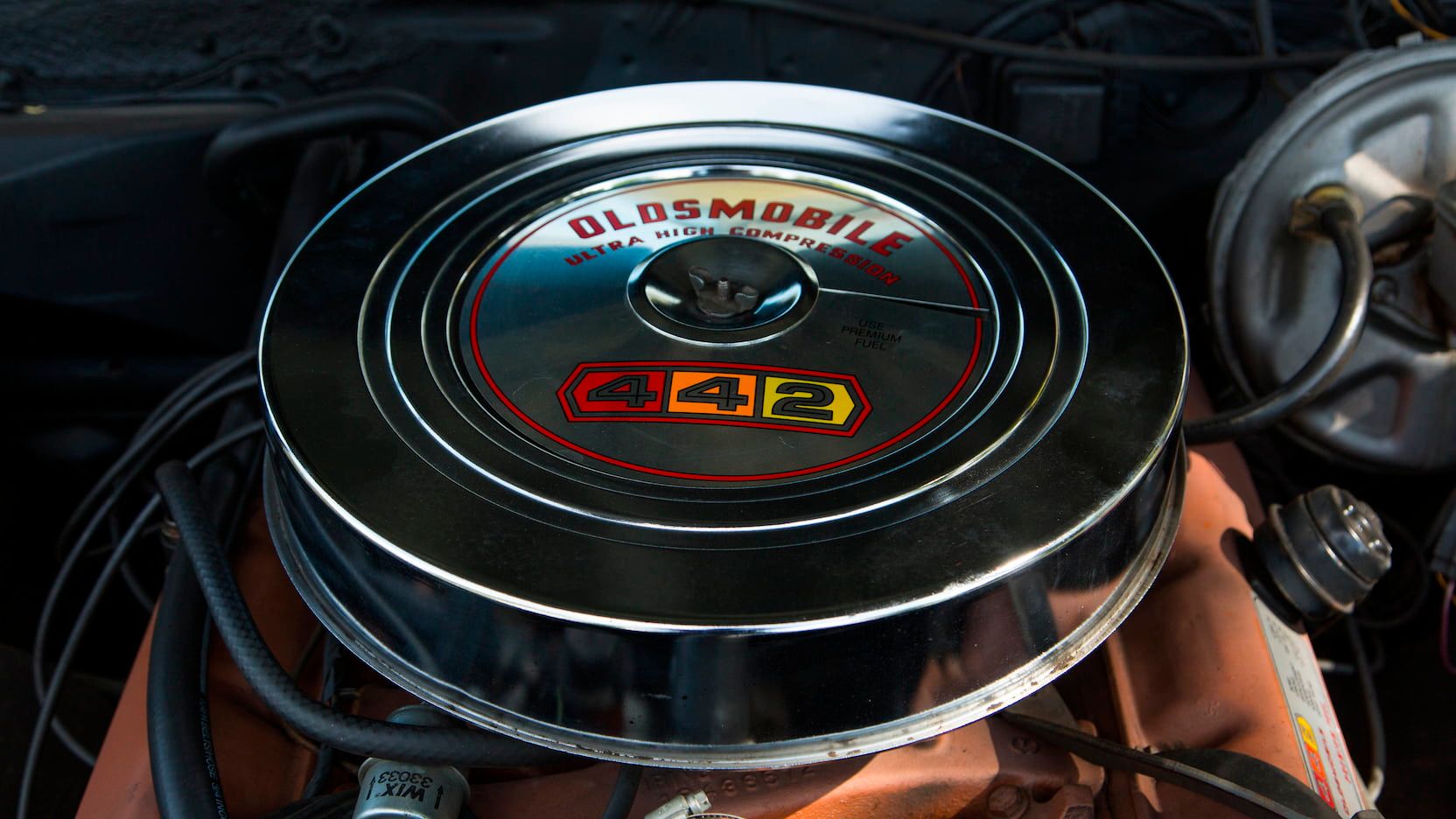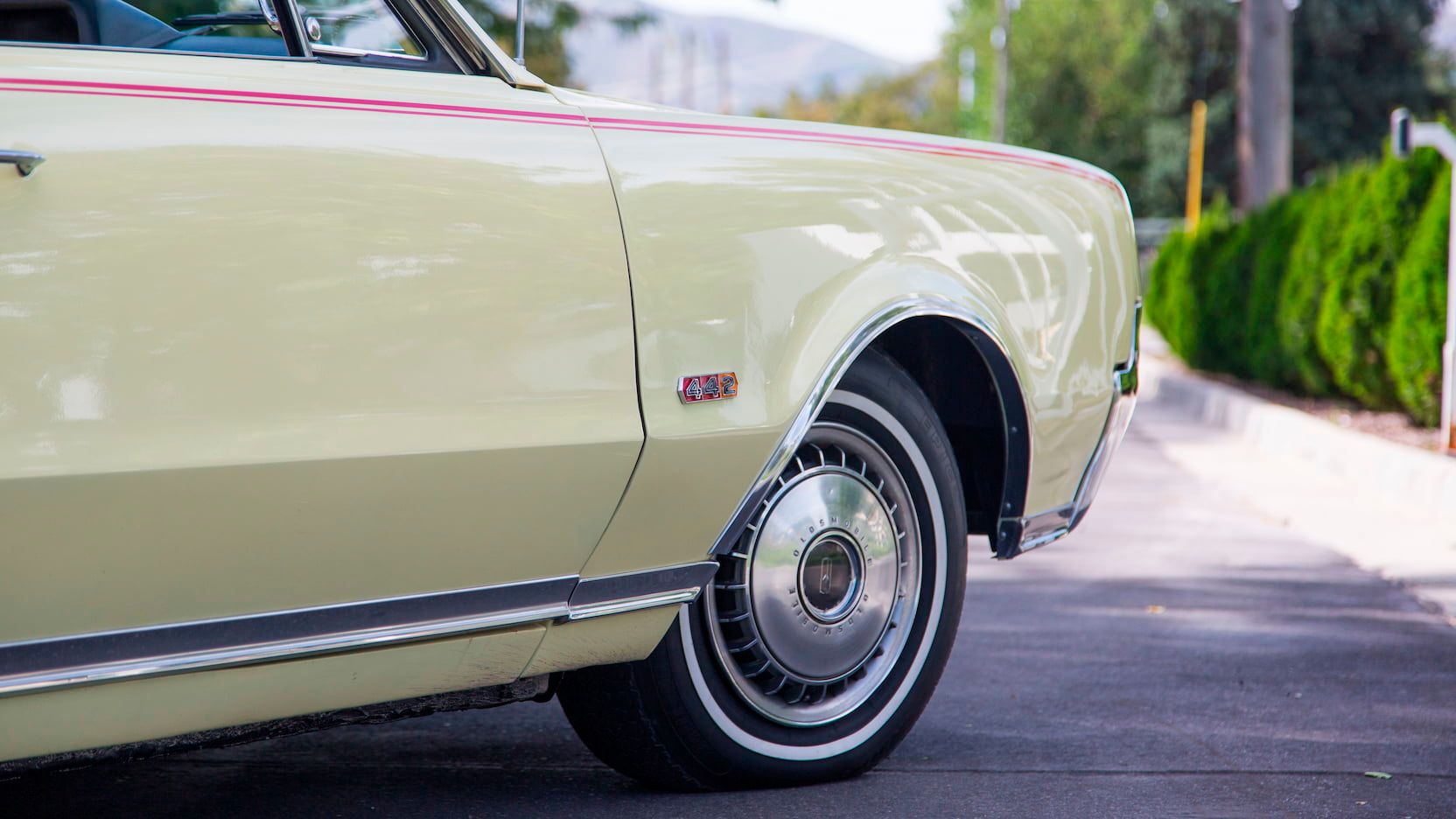The Oldsmobile 442, or 4-4-2 as it was advertised and sold in period, was one of the first muscle cars to appear after Pontiac released the Tempest-based GTO. The 1967 model featured a 6.5-liter V-8 that pushed out 350 horsepower but lacked the styling to match its performance figures.
The 442 debuted in September of 1963 for the 1964 model year as the performance trim level of the Cutlass. As a consequence, it was equipped with the biggest engine that GM would allow on a mid-size car at the time, a 5.4-liter V-8 with a four-barrel carburetor that was rated at 310 horsepower. In fact, the 442 nameplate originally pointed out to the car's setup: its quad-barrel carburetor, four-speed gearbox, and twin-pipe exhaust system.
Oldsmobile's first muscle car was available as a two-door hardtop, a two-door convertible, and even a four-door sedan. Up until 1967, you could have the 442 trim level on either the F-85 or the Cutlass base. However, for the first generation's final production year, the 442 was based on the ultimate version of the Cutlass Supreme, further proving the 442's special status. It became a standalone model when the second generation debuted in 1968.
Keep reading to learn more about the 1967 Oldsmobile 442 Convertible
1967 Oldsmobile 442 Convertible
- Make: Array
- Model: 1967 Oldsmobile 442 Convertible
- Horsepower: 350 @ 5000
- Torque: 440 @ 3600
- [do not use] Vehicle Model: Array
1967 Oldsmobile 442 Convertible Exterior
The 1967 Oldsmobile 442 kept rolling with the changes effected to the Cutlass and F-85 range the previous year when the by-now-classic 'Coke bottle design' was introduced. However, the front end was updated again. Oldsmobile categorized the 442 at the time as a sports car since its "cool good looks equally at home at a sports car rally or on a quiet Sunday ride," as quoted by HowStuffWorks.com ().
The company targeted its sports car towards younger folks that wanted to get an extra bang for their buck. That's is why the term "Youngmobiles" was used in Olds' ad campaigns at the time. It may seem like a stretch to call the boat-like 442 a car for teenagers but, indeed, that's how Oldsmobile positioned the 442.
The lower part of the grille frame actually follows the shape of the grille which opens up a lower air inlet just below. In fact, the lower part of the grille frame is made up by the upper section of the front bumper which also wraps around the protruding fenders that edge out in front of the center panel. Another novelty for 1967 was the introduction of a louvered hood that came down to meet with the grille.
From the side, you can really see the sheer size of its car. Its wheelbase is 115 inches, three more than the 1968 model.
On the convertible, the line of the front fenders goes all the way back behind the doors where a small hump makes it jink higher to go over the rear fenders. A double red stripe is traced from the edge of the front bumper, all the way towards the rear quarter panel. Another thing that springs into view is the windshield with its A-pillars, and the rest of the frame, colored in the Triple Saffron Yellow tint that adorns the rest of the bodywork as well. More chrome can be found towards the lower edge of the bodywork. There's a chromed bar that follows the edge of the front and rear overhangs, and one that dashes across the rocker panel. Another 442 badge sits just aft of the front wheel well.
This 442 comes with turbine-style full-size wheel covers and white wall tires. Other 442s at the time, especially W-30-optioned models, came with Rallye wheels and redline tires.
1967 Oldsmobile 442 Convertible Exterior Dimensions:
|
Length: |
204.2 inches |
|
Width: |
76 inches |
|
Wheelbase: |
115 inches |
|
Height: |
52.3 inches (with roof) |
1967 Oldsmobile 442 Convertible Interior
Morocceen vinyl upholstery covers most of the interior of the 1967 Oldsmobile 442. Indeed, as per the original specifications, it comes with twin strato bucket seats up front and a notchback bench seat right behind.
This example comes with both a tachometer and an odometer, the tachometer being an option back in 1967 when automakers reckoned their customers should know when to shift simply by listening to the engine. That's, maybe, why Oldsmobile called it in other ads the ''anti-boredom machine". Anyway, this car has a big round tachometer to fit the equally big odometer placed to the left. The whole dash panel is recessed on this 1967 model following government-mandated safety requirements that included the fitting of an energy-absorbing steering column and, also, the padding of the gauge cluster in the process.
The top part of the panel is colored in silver and it's there that Oldsmobile placed the air vents and a number of knobs and buttons.
Most 442s, just like this one, came from the factory with a ''3-on-the-tree" automatic transmission. In other words, the shifter is placed right behind the 3-spoke black steering wheel on the steering column. A center console was an optional extra for 1967 and this convertible doesn't have it.
1967 Oldsmobile 442 Convertible Drivetrain
The standard engine on a 1967 442 was the 6.5-liter V-8. It came with either a twin-barrel carburetor or a four-barrel one. Since GM banned multi-carburetor engines in any production models but for the Corvette in 1967, the 442 had to make do with a single Rochester Quadrajet carburetor. Still, even in this guise - and without the W-30 performance package - the OHV 16-valve engine was good enough for 350 horsepower at 5,000 rpm and 440 pound-feet of torque at 3,600 rpm. The engine would redline at 5,200 rpm.
All that power, as mentioned, was sent to the back wheels through the 3-speed Turbo Hydramatic transmission. a 2-speed Jet-Away automatic was also available at the time, as well as a couple of manual transmissions with either 3 forward gears or four. The latter, of the Muncie M20/M21 variety, came with Hurst shifters.
The car had independent suspension up front with upper and lower A-arms, coil springs, and a sway bar. At the rear, a solid axle makes room for coil springs and another sway bar. The 442 comes with heavy-duty suspension that further enhances the car's driveability although its prowess remained in straight line. The suspension, on paper, was meant to minimize the car's tendency to lift the nose under heavy acceleration off the line.
With that being said, Car & Driver said back in 1967 that the 442 is the "best-handling car of its type we've ever tested," and that it's a "driver's car" according to HowStuffWorks.com.
All in all, the 442 of 1967 did have the performance that would qualify it as a muscle car but it didn't have the looks. At least, it was about to change for 1968.
1967 Oldsmobile 442 Convertible Specifications:
|
Engine: |
GM Oldsmobile V-8 400 OHV 16-valve naturally-aspirated 6.5-liter engine |
|
Output: |
350 horsepower at 5,000 rpm |
|
Torque: |
440 pound-feet of torque at 3,600 rpm |
|
Bore x stroke: |
4.00 inches x 3.98 inches |
|
Compression ratio: |
10.5:1 |
|
Fuel feed: |
Single Rochester Quadrajet four-barrel carburetor |
|
0-60 mph: 7.8 seconds |
|
|
Top speed: |
130 mph |
|
Suspension: |
Heavy-duty independent up front with upper and lower A-Arms, coil springs and an anti-roll bar while, at the back, there was a solid axle with coil springs and an anti-roll bar |
|
Brakes: |
Power-assisted drums on all four corners |
1967 Oldsmobile 442 Convertible Pricing
A Cutlass-based 442 Convertible was priced at about $3,200 back in 1966/7 which was only $150 more than what you had to pay for a standard Cutlass. In today's money, a new Cutlass Convertible perfect for the warm summer days cost just under $24,000.
A total of 24,833 442s were built in 1967, up by almost 4,000 compared to 1966, which means the final-year generation-one model isn't that rare - but there's a catch. If you want a convertible, you'll have to dig deeper since only 3,104 convertibles were ever assembled. Mecum, who organized the auction where this car showed up this weekend, point out to an approximate value of $30,000-$40,000 although, out on the market, you can find examples selling for as much as $50,000.
1967 Oldsmobile 442 Convertible Competition
1964-1969 Buick Special Hardtop Coupe
The fifth-generation Buick Special (if you count the pre-War models too) debuted in 1964 with brand-new styling which was now sitting on the A-body platform that featured typical body-on-frame construction. The mid-size Special came in a variety of body styles including the sporty 2-door hardtop coupe and 2-door convertible. It's interesting to notice that the Special reverted from the unibody construction of the '61-'63 Y-body model to a body-on-frame architecture for 1964.
While not a muscle car as such, since it never came with engines bigger than those usually seen on intermediate cars at the time, it had the allure and size of a Tempest-GTO or Cutlass-442. As such, the biggest-capacity engine available on the '64-'69 Special was the 5.6-liter V-8 with cast iron heads. It developed 260 horsepower at 4,200 rpm and 365 pound-feet of torque at 2,800 rpm.
Just like the 442, the engine was fed by a four-barrel Rochester carburetor. The 2-door Special also had the same wheelbase as the 442. However, it was a whole 400 pounds lighter than the Oldsmobile and also cheaper.
Pontiac GTO
The GTO, named after Ferrari's World Championship-winning 250 GTO, is one of the first real muscle cars, a car that kicked-off a phenomenon that would last all the way until the dawn of the '70s: the muscle car craze. It was based on the second-generation Pontiac Tempest and, just like the 442, it acted as a performance-oriented trim level of the Tempest. It also shared the A-body platform with the Buick Special and the Oldsmobile 442.
The car, created by a team led by John DeLorean, Bill Collins, and Russ Gee, was the first that ignored GM's policy that limited engine capacity for mid-size cars to 5.4-liters and came with a 6.4-liter V-8 that was usually found under the hood of full-size Catalinas. While road tests at the time criticized the car's slow steering, especially in unassisted form, the people loved it: over 32,000 Tempests were bought with the GTO package in 1964 alone.
The Pontiac GTO went through its most important restyling procedure for the 1965 model year when it received the legendary quad headlights, stacked two-by-two outboard of the twin-piece grille. That's also when the GTO grew a bit, by about 3 inches, gaining the classic 'Coke bottle' shape we all have come to know and love.
The 6.4-liter V-8 of the original GTO developed 325 horsepower at 4,800 rpm when fed by a single Carter AFB carburetor. Later on, a three-carburetor version appeared which put out 350 horsepower. It was adequately known as the "Tri-Power" model. The GTO came with the usual handling enhancements at the time like stiffer springs, a bigger rear anti-roll bar, and bigger brakes. The "Tri-Power" model came with a limited-slip differential and improved cooling. The weight was rated at 3,500 pounds, lighter than the 442 but heavier than the Special. The GTO's MSRP when new was $36,000 in today's money.
Conclusion
The Oldsmobile 442 is the first sign that an intra-corporation fight in the muscle car arena was sparked. GM would subsequently put out a variety of compact and mid-size muscle cars in the years to come and part of this fleet was the 442 that grew and evolved along with its siblings from other manufacturers within GM.
Should you buy a first-generation 442? It's a pertinent question whose answer resides more in what you want from a muscle car than what it has to offer. If your quest is to find the most understated of all muscle cars, you might just be upon it since the original 442 looks more like a land barge than like a "sports car", as Olds' put it. Still, it delivers its fair share of thrills thanks to the 350-horsepower engine - which is more than what a 208 Honda Civic Type R makes - V-8 engine. It also sounds great with the combo of engine and two-pipe exhaust system. Finally, if you find a convertible for the right amount of money, you'll have something to roll around during the hot summers that are set to melt us in the coming years.
Further reading
Read our full review on the 1970 Oldsmobile 442 W-30 Convertible.

